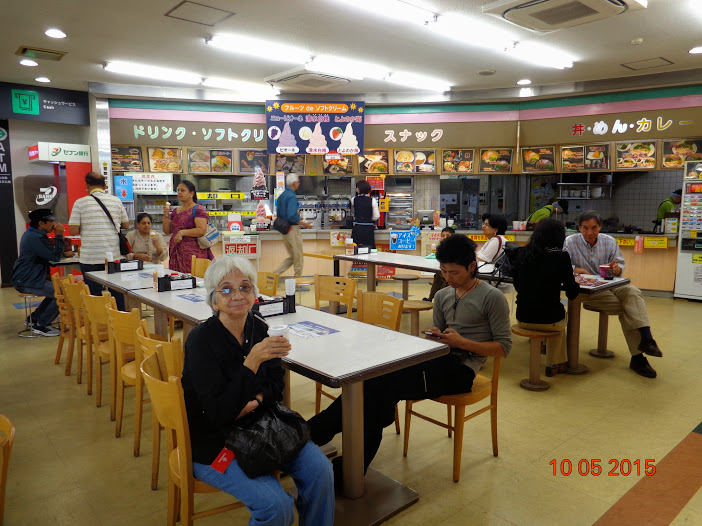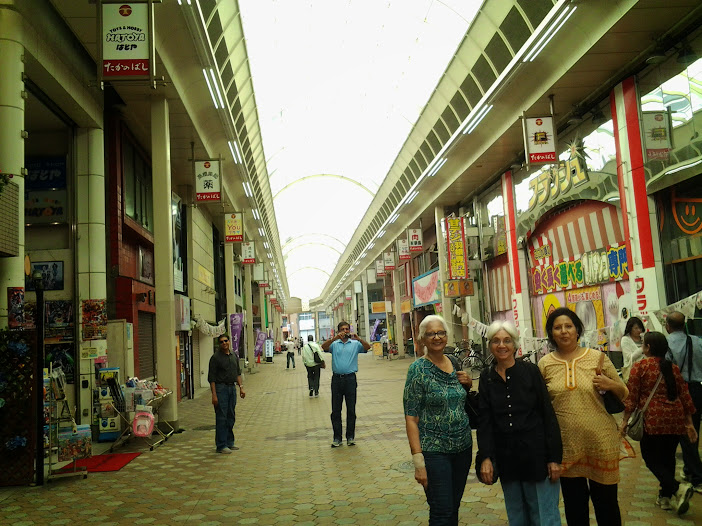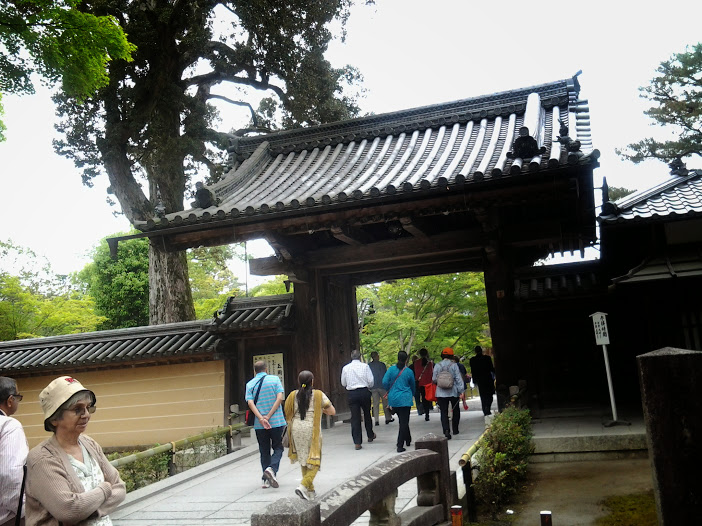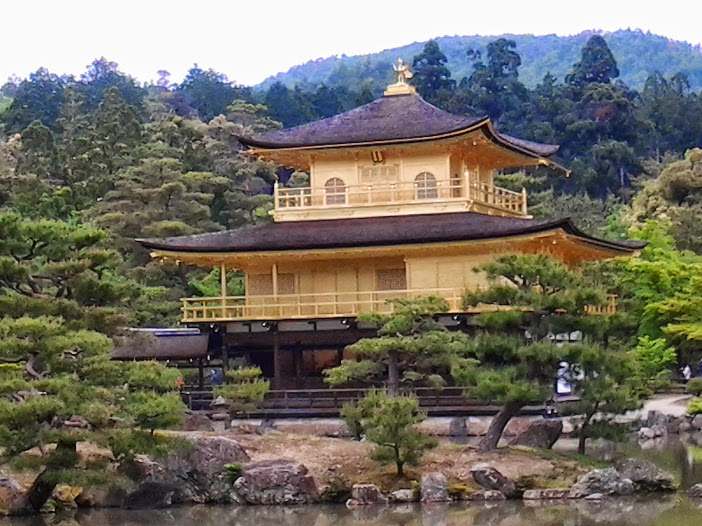DAY THREE - 10 May 2015. HIROSHIMA
Today we leave for Hiroshima . So the three timings for the day were advanced by 30 mts. Now they were 0600 wakeup , 0700 Breakfast and 0800 departure .
It was to be a road journey with one halt enroute . As on previous days , Starting of on time was not much of a problem and we set course more or less at the decided time of 0800 We followed Sanyo Expressway . Distance to Hiroshima on this route is approx 340 KMs.
At Hotel Otani, my pre breakfast photo sessions were done on previous days, no photos were taken pre breakfast . However for the life of me I can not remember why I did not take any photos of our start or enroute till we reached our first halt on the way . So it comes to pass that the first photo of DAY THREE was taken at Kibi Service Area on Sanyo Expressway about 180 KMs from Osaka.
First photo day three.
Photo taken at Halt at Kibi Service Area . Sanyo Express way . Enroute Osaka - to - Hiroshima.
In one of the Japanese blog this statue is mentioned as "Sanyo Road Millet with three animal companions"
In one of the Japanese blog this statue is mentioned as "Sanyo Road Millet with three animal companions"
Started on road journey from Osaka to Hiroshima on Sanyo Express Road . Approximate Distance of 340 Kms. Halt at Kibi Service Area . Almost half way,for Tea , Coffee and snacks Break.
Panoramic view Kibi Service Area
Good facilities for a break after long drive . All facilities available.
Kibi Service Area . A refreshing Coffee and eats if you want them .
Knick knacks , Fruits and what have you . All at Kibi Service Area. :-)
After halt of about 30-45 mts took to Sanyo Expressway and were away for Hiroshima . On the way saw some examples of of Japanese Green House Farming . Have no idea what was being cultivated , took photos nevertheless.
It was approaching lunch time so we proceeded to Ganesh Indian Restaurant in
After halt of about 30-45 mts took to Sanyo Expressway and were away for Hiroshima . On the way saw some examples of of Japanese Green House Farming . Have no idea what was being cultivated , took photos nevertheless.
Greenhouse Farming.
Greenhouse Farming .
Village scene en-route to Hiroshima in the vicinity of Kaita Ohashi Bridge . The Hills form part of Ogonzan Ryokucchi Park.
Flyovers - Flyunders galore . In the vicinity of Kaita Ohashi Bridge. Hiroshima just about 30 Mts away.
It was approaching lunch time so we proceeded to Ganesh Indian Restaurant in
Hondori Street Arcade , Hiroshima .
Hondori Street Aracade, in the neighbourhood of Senda Dori Avanue , Nara Ward , Hiroshima .
Ganesh Indian Restaurant.We had lunch here .
Takanoshi Central Hospital seen from the Eastern end of Hondori Street.
The Road Junction near Eastern end of Hondori Street .
A word about Hiroshima .
It will be difficult to find a person with decent education who has not heard about Hiroshima and Nagasaki the two Japanese cities ,to be attacked with Atomic bomb. The only cities in the history of mankind , of human existence , to be subjected to such an attack .
A uranium gun-type atomic bomb (Little Boy) was dropped on Hiroshima on August 6, 1945, and Hiroshima got the unfortunate and dubious distinction to become the first city in Human History to be the target of Atom Bomb .
The bomb which was dropped was named " Little Boy". It contained about 64 kg (141 lb) of uranium-235 took 44.4 seconds to fall from the aircraft flying at about 31,000 feet (9,400 m) to a detonation height of about 1,900 feet (580 m) above the city . It created a blast equivalent to 16 kilotons of TNT . The radius of total destruction was about 1 mile (1.6 km), with resulting fires across 4.4 square miles (11 km2).Some 70,000–80,000 people, of whom 20,000 were soldiers, or around 30% of the population of Hiroshima, were killed by the blast and resultant firestorm, and another 70,000 injured.Hiroshima was a destroyed and devasted city after the bombing.
Hiroshima was rebuilt with heroic and collective efforts of the common Japanese People and very efficient Government.But they created " Hiroshima Peace Memorial Park " at Hiroshima and similar countless memorials and monuments across all over Japan so that the people and the world at large never forgets the horrors of an Atomic attack .
There are almost 23 sites listed as tourist attractions . Some Main amongst them are Hiroshima Peace Memorial Park and associated Monuments,Shukken (Japanese Garden),HiroshimaCastle, Itsukushima(Shrine Island),Hiroshima Prefectural Art Museum and Hiroshima Museum Of Arts.
We saw only one of them : Hiroshima Peace Memorial Park and associated Monuments / Memorials .
Hiroshima Peace Memorial Park
Atomic Bomb Memorial Mound on the left . The Mound is flanked by two stone Lanterns . One is on the right of photo . The other one on is in shadow & not visible.
The Figure of the Merciful Goddess of Peace (Kannon).
Memorial Monument for Nakajima-hon-machi Residents .Nakajima Hon-machi was 100~700 meters from the hypocenter. What the the inscription beside the figure reads is given in comments coloumn of photo in the album.
Entry Gate . Main Building Hiroshima Prace Memorial Museum .
Scale model showing devastation and destruction caused by Atom bomb explosion in Hiroshima . Because of the proximity fuse settings The bomb had exploded at pre determined height above ground . about 1900 ft The height was set on purpose to cause maximum destruction . Red sphere indicates the height and the place above which the Bomb exploded. The point on ground below the red sphere is known as " Hypo Centre " .
Statue of Prayer - Hiroshima Peace Memorial Park. The figures of a young couple holding their child in their arms are the work of the sculptor, Yoshizumi Yokoe.
The Children's Peace Monument.
The monument is in the memory of Sadako Sasaki, a young girl who contracted Lukemia as a resrult os exposure to Atomic Radiation . Some how she believed that if che could make 1000 paper cranes she would be cured . Thousands of origami cranes from all over the world are offered around the monument.
See the comments on these photos in album.
Memorial Cenotaph.
The lobby Royal Righa Hotel.
Boutique and Faishon Hall at Rihga Royal Hotel . Hiroshima.
Shops at Rihga Royal Hotel .
The bomb which was dropped was named " Little Boy". It contained about 64 kg (141 lb) of uranium-235 took 44.4 seconds to fall from the aircraft flying at about 31,000 feet (9,400 m) to a detonation height of about 1,900 feet (580 m) above the city . It created a blast equivalent to 16 kilotons of TNT . The radius of total destruction was about 1 mile (1.6 km), with resulting fires across 4.4 square miles (11 km2).Some 70,000–80,000 people, of whom 20,000 were soldiers, or around 30% of the population of Hiroshima, were killed by the blast and resultant firestorm, and another 70,000 injured.Hiroshima was a destroyed and devasted city after the bombing.
Hiroshima was rebuilt with heroic and collective efforts of the common Japanese People and very efficient Government.But they created " Hiroshima Peace Memorial Park " at Hiroshima and similar countless memorials and monuments across all over Japan so that the people and the world at large never forgets the horrors of an Atomic attack .
There are almost 23 sites listed as tourist attractions . Some Main amongst them are Hiroshima Peace Memorial Park and associated Monuments,Shukken (Japanese Garden),HiroshimaCastle, Itsukushima(Shrine Island),Hiroshima Prefectural Art Museum and Hiroshima Museum Of Arts.
We saw only one of them : Hiroshima Peace Memorial Park and associated Monuments / Memorials .
Hiroshima Peace Memorial Park
Hiroshima Peace Memorial Park is a memorial park in the center of Hiroshima, Japan. It is dedicated to the legacy of Hiroshima as the first city in the world to suffer a nuclear attack, and to the memories of the bomb's direct and indirect victims (of whom there may have been as many as 140,000).
The location of Hiroshima Peace Memorial Park was once the city’s busiest downtown commercial and residential district. The park was built on an open field that was created by the explosion and spread over an area of 120,000 square meters.I am 100% sure that the problem of relocation of those living at this site earlier wae never politisied as it is a common thing to do in India in erlocation of Project Affected People . If it was also politicised in Hiroshima the city would still have devasteted look .
Today there are a number of memorials and monuments, museums, and lecture halls, which draw over a million visitors annually. Quite afew of minor memorials were built by the people/ descendents of the people living in that area before the area was destroyed or by people affor who suffered by the divastetetion. One example of such a memroal is memorial for Korean victims.
Monument dedicated to Korean Victims and Survivors .This is a monument to all the Korean nationals who were killed or injured by the Hiroshima atomic bomb on 6th August 1945. It wasn't just Japanese who were killed by the bomb. It's believed that around 30000 of the 70000 to 80000 people who died immediately in the blast were Korean nationals, while another 20000 were exposed but survived immediate death.
Atomic Bomb Memorial Mound on the left . The Mound is flanked by two stone Lanterns . One is on the right of photo . The other one on is in shadow & not visible.
The Figure of the Merciful Goddess of Peace (Kannon).
Memorial Monument for Nakajima-hon-machi Residents .Nakajima Hon-machi was 100~700 meters from the hypocenter. What the the inscription beside the figure reads is given in comments coloumn of photo in the album.
Entry Gate . Main Building Hiroshima Prace Memorial Museum .
Scale model showing devastation and destruction caused by Atom bomb explosion in Hiroshima . Because of the proximity fuse settings The bomb had exploded at pre determined height above ground . about 1900 ft The height was set on purpose to cause maximum destruction . Red sphere indicates the height and the place above which the Bomb exploded. The point on ground below the red sphere is known as " Hypo Centre " .
Statue of Prayer - Hiroshima Peace Memorial Park. The figures of a young couple holding their child in their arms are the work of the sculptor, Yoshizumi Yokoe.
The Children's Peace Monument.
The monument is in the memory of Sadako Sasaki, a young girl who contracted Lukemia as a resrult os exposure to Atomic Radiation . Some how she believed that if che could make 1000 paper cranes she would be cured . Thousands of origami cranes from all over the world are offered around the monument.
See the comments on these photos in album.
Memorial Cenotaph.
Near the center of the park is a concrete, saddle-shaped monument that covers a cenotaph holding the names of all of the people killed by the bomb. The monument is aligned to frame the Peace Flame and the A-Bomb Dome. The Memorial Cenotaph was one of the first memorial monuments built on open field on August 6, 1952. The arch shape represents a shelter for the souls of the victims.
Atomic Bomb Dome . Hiroshima.
The A-Bomb Dome is the skeletal ruins of the former Hiroshima Prefectural Industrial Promotion Hall. It is the building closest to the hypocenter of the nuclear bomb that remained at least partially standing. It was left how it was after the bombing in memory of the casualties .
Afterlooking around for some more time and taking a few more photographs it was time to proceed for Dinner , We went to the same Ganesh Indian Restaurant where we had lunh in the afternoon . After dinner it was to Rihga Royal Hotel . Hiroshima.
While allotments of room etc was being done I took some photos.
Boutique and Faishon Hall at Rihga Royal Hotel . Hiroshima.
Shops at Rihga Royal Hotel .
Our Room in Righa Royal.
Actually this was the last photo of DAY THREE but I wanted to end the blog with this photo
The Roses Righa Royal Hotel .
Tomorrow we check out of Righa Royal Hotel, Hiroshima and proceed to Tokyo, by Bullet Train but ,Via Fuji Visitors Point and two other points if Interest .
Here is the link for photo album of China- Japan Trip : Japan: DAY THREE
https://plus.google.com/u/0/photos/100798393236899222624/albums/6174944404182552145
Please Do read the captions and info given in the comment column of photos.
Also check out mapped position . If you are interested you may even see the street view of the photo.I hope it will be an interesting experience :-)
GOOD NIGHT DAY THREE.




































































